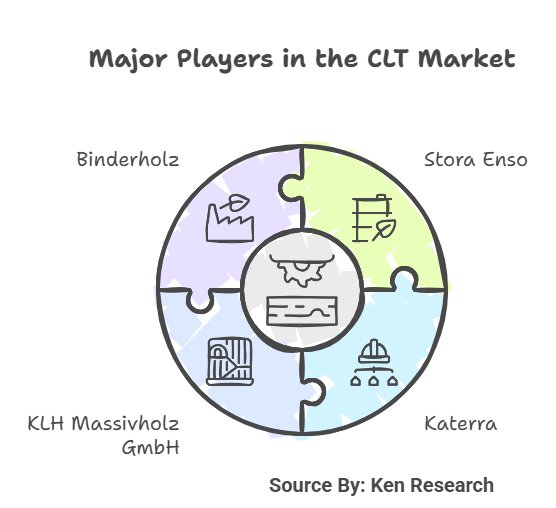Milestones of the Global CLT (Cross-Laminated Timber) Market: Growth, Trends, and Future Outlook
This blog will provide a milestone-based analysis of the CLT market, covering market size and growth, sustainability trends, technological advancements, and key challenges faced by the industry.

The Global Cross-Laminated Timber (CLT) Market has emerged as a transformative force in the construction and building materials sector. As the demand for sustainable, environmentally friendly materials grows, CLT offers a versatile and eco-friendly solution to modern architecture and construction needs.
CLT Market Size and Growth Analysis
Milestone 1: Market Growth and Forecast
The CLT market has experienced significant growth over the past decade, and it is projected to continue its upward trajectory. As demand for sustainable building materials increases, the CLT market size is expected to reach USD 3.5 billion by 2027, growing at a CAGR of 12%. The adoption of cross-laminated timber in both residential and commercial construction is becoming more widespread, driven by growing awareness about climate change, carbon footprints, and the need for sustainable construction practices.
Key Insights:
- North America and Europe are the leading regions driving the demand for CLT, due to green building certifications and strong government support for eco-friendly construction.
- Asia-Pacific is an emerging market for CLT, with countries like China and Japan adopting CLT as part of their sustainability strategies in urban construction.
Sustainability Trends in the Cross-Laminated Timber Industry
Milestone 2: Sustainability and Environmental Benefits
The use of cross-laminated timber in construction is gaining traction due to its environmental sustainability and carbon sequestration capabilities. CLT is made from renewable timber, which acts as a carbon sink by absorbing carbon dioxide during its growth. Unlike traditional building materials such as steel and concrete, CLT offers significant reduced carbon emissions over its lifecycle.
Key Sustainability Trends:
- Carbon Neutrality: CLT is being promoted as part of the sustainable construction movement to reduce the overall carbon footprint of the built environment.
- Eco-friendly Benefits: With the global cross-laminated timber analysis push for eco-friendly buildings and net-zero carbon emissions, CLT is becoming an increasingly popular choice for both residential and commercial developments.
- Green Certifications: CLT is being integrated into projects aiming for LEED (Leadership in Energy and Environmental Design) and BREEAM (Building Research Establishment Environmental Assessment Method) certification, ensuring its status as a sustainable material.
Market Segmentation of CLT by Application and Region
Milestone 3: Application-Based and Regional Growth Segmentation
The CLT market is segmented based on applications and regions, providing insights into the diversity of its uses across different types of construction and its varying adoption rates globally.
Segmentation by Application:
- Residential Construction: CLT is increasingly being used for multi-story residential buildings, where its strength, lightweight nature, and sustainability make it an attractive alternative to traditional concrete and steel.
- Commercial Construction: CLT is gaining momentum in office buildings, retail spaces, and mixed-use developments due to its ability to create large open spaces with minimal interior columns.
- Infrastructure: Bridges, schools, and public buildings are incorporating CLT due to its cost-effectiveness, strength, and durability.
Segmentation by Region:
- Europe remains the largest market, with countries like Austria, Germany, and Sweden leading the adoption of CLT in residential and commercial projects.
- North America is seeing strong demand, especially in the U.S. and Canada, where the push for sustainable urban development is driving the adoption of CLT.
- Asia-Pacific is emerging as a potential growth region, particularly in Japan, which has been a pioneer in using CLT for seismic-resilient construction.
Competitive Landscape of CLT Manufacturers
Milestone 4: Key Players and Competitive Dynamics
The CLT market is characterized by a mix of global players and regional manufacturers, with companies investing heavily in production capacity and innovation to meet the growing demand for CLT.
Key Players:
- Stora Enso: A leading producer of CLT, Stora Enso focuses on sustainable timber products and has a significant presence in Europe and North America.
- Katerra: This global player combines technology and manufacturing to offer CLT products in both residential and commercial projects, particularly in North America.
- KLH Massivholz GmbH: Known for its high-quality CLT panels, KLH operates in Austria and supplies products worldwide.
- Binderholz: A key player in the CLT production market, Binderholz has expanded its production capabilities to meet rising demand, particularly in Europe.

Competitive Strategies:
- Companies are focusing on expanding production capacity, investing in advanced manufacturing technologies, and improving supply chain management to maintain their competitive edge.
- Innovation in product customization and finishing options is also helping companies cater to diverse construction needs.
Impact of Government Regulations on CLT Market Growth
Milestone 5: Regulatory Influence on CLT Adoption
Government regulations and building codes are essential in driving the adoption of CLT as a mainstream construction material. Governments in various countries are increasingly recognizing the importance of sustainable building materials to combat climate change.
Key Regulatory Insights:
- Building Codes: Countries such as Canada, Germany, and Austria have implemented building codes that allow for multi-story buildings using CLT, which was previously not permitted.
- Incentives and Subsidies: Governments are offering financial incentives and subsidies for the adoption of green building materials, including CLT, as part of their efforts to reduce carbon emissions.
- Research and Development: National governments are funding research initiatives to improve CLT manufacturing processes in industry, enhance material performance, and lower costs for large-scale adoption.
Technological Advancements in CLT Production
Milestone 6: Innovation and Production Advancements
Technological advancements in CLT production are a key enabler of the market’s growth, reducing costs and improving product quality. Automation and robotics have revolutionized the manufacturing process, enabling faster, more efficient production.
Key Advancements:
- Automated Production Lines: The introduction of automated production lines for CLT manufacturing has drastically reduced the time required to produce panels, increasing overall production efficiency.
- Digitized Design and Manufacturing: Companies are adopting digital design tools such as BIM (Building Information Modeling) to optimize the design and manufacturing of CLT panels, enhancing precision and customization.
- Sustainability Innovations: New techniques in sustainable timber sourcing and recycling are reducing waste and increasing the environmental benefits of CLT.
Investment Opportunities in the CLT Market
Milestone 7: Growth Opportunities in CLT
The increasing demand for sustainable building materials presents significant investment opportunities in the CLT market. Both private and public sectors are keen to support innovations that reduce the environmental impact of construction.
Investment Drivers:
- Green Construction: Investors are focusing on CLT as a solution to meet the growing demand for green buildings, particularly in urban areas where sustainability is a major priority.
- Public Funding: Governments are providing financial incentives to encourage the construction of CLT buildings, particularly for public infrastructure and housing projects.
- Venture Capital: Startups and technology innovators are attracting venture capital funding to develop advanced CLT production methods, improve efficiency, and scale up production.
Future Outlook of the Cross-Laminated Timber Market
Milestone 8: Market Trends and Future Projections
The future of the CLT market looks promising, with significant growth expected as more countries embrace sustainable construction practices and CLT becomes a common building material for both residential and commercial buildings.
Future Insights:
- Urbanization and Sustainability: As cities grow and demand for sustainable housing and commercial spaces increases, CLT is poised to become a core material for eco-friendly urban development.
- Increased Global Adoption: With Asia-Pacific and North America emerging as key growth markets, CLT production and adoption will expand globally.
- Technological Enhancements: Innovation in manufacturing processes and the enhancement of CLT’s structural capabilities will further boost its appeal and adoption in large-scale commercial construction.
For a deeper understanding of the Cross-Laminated Timber (CLT) market, including growth projections, investment opportunities, and regional adoption trends, download your free sample report from Ken Research today!
Challenges in Large-Scale Adoption of CLT
Milestone 9: Overcoming Barriers to Widespread Adoption
Despite the benefits, large-scale adoption of CLT still faces challenges. These include perceptions of fire resistance, material cost, and lack of trained labor for CLT construction projects.
Challenges:
- Building Code Restrictions: In some regions, building codes still limit the use of CLT in multi-story buildings, although regulatory progress is being made.
- High Initial Costs: The initial cost of CLT panels remains higher than traditional materials such as concrete and steel, though the long-term cost benefits outweigh the initial investment.
- Skilled Workforce: There is a shortage of skilled professionals trained in CLT construction, which can slow the adoption of this material in new projects.
Cost-Benefit Analysis of CLT vs. Traditional Building Materials
Milestone 10: Cost Efficiency and Benefits
A detailed cost-benefit analysis reveals that while CLT may have higher upfront costs compared to traditional building materials like steel and concrete, the long-term benefits such as energy efficiency, carbon sequestration, and faster construction make it a more cost-effective choice for sustainable buildings.
Key Insights:
- Long-Term Savings: CLT buildings can lead to lower operating costs, including energy costs, due to better insulation and thermal efficiency.
- Reduced Construction Time: CLT’s lightweight and prefabricated nature reduces construction time, resulting in cost savings during project development.
- Environmental and Regulatory Benefits: The environmental benefits of using CLT in construction, including its carbon-neutral potential, provide an added value that traditional materials cannot offer.
Conclusion
The global Cross-Laminated Timber (CLT) market is poised for significant growth as demand for sustainable, eco-friendly construction materials continues to rise. While challenges such as cost, regulatory approval, and skilled labor shortages persist, the future outlook for CLT remains positive. Technological innovations, growing demand for green buildings, and the regulatory push for sustainable urban development will drive the continued expansion of the CLT market worldwide.
What's Your Reaction?






















